Le Thoureil to Juigné-sur-Loire
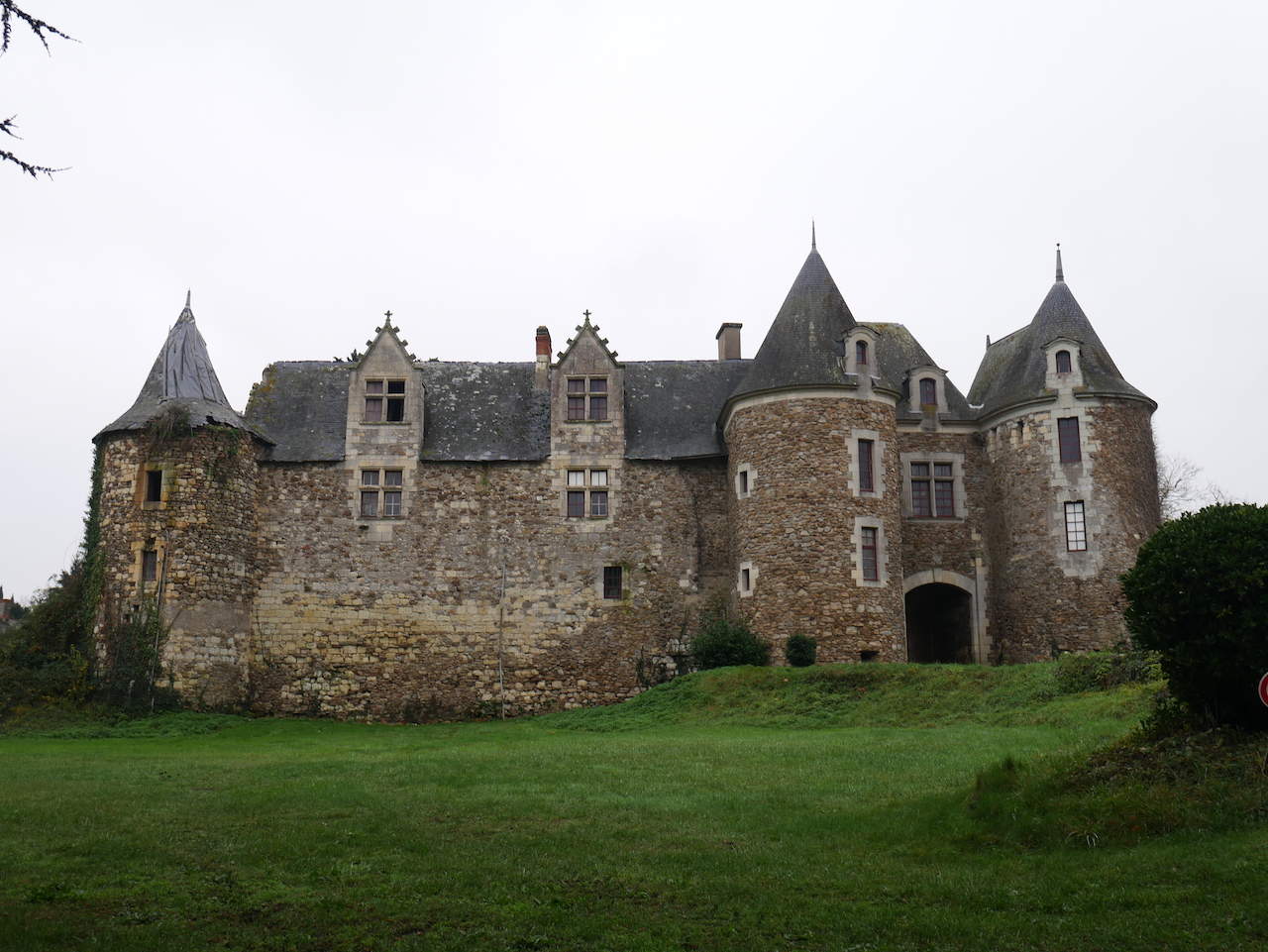
Pays de la Loire
14. Le Thoureil to Juigné-sur-Loire
Medium
6h
23,5km
+317m
-327m
Step
Embed this item to access it offline
A day in the vineyards and then in small forests alternating with cereal crops.
6 points of interest
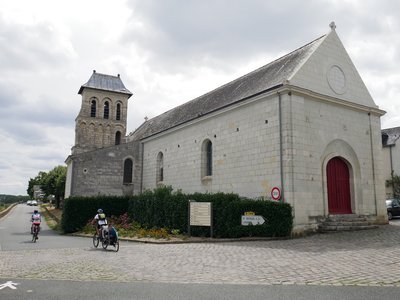
Église Saint-Genulf et Saint-Charles à Le Thoureil - Amis saint Colomban TouristSaint-Genulf and Saint-Charles Church in Le Thoureil
The church of Saint-Genulf du Thoureil was built in the 11th century on the alluvial terrace on the banks of the Loire, out of reach of the floods of the Loire. It was in the 13th century that the bell tower was built on the Loire side.
The construction of the Grande Levée d'Anjou from the 12th century, on the right bank of the river will have harmful repercussions on the sanctuary. The rise of the flood level, the acceleration of the current will undermine and reduce the bank. In the 18th century, the church, invaded by the highest waters, was disused and abandoned in 1781. In 1807, a new church was rebuilt and consecrated under the name of Saint-Charles.
Two very beautiful hunts from the Abbey of Saint-Maur de Glanfeuil are displayed on each side of the choir.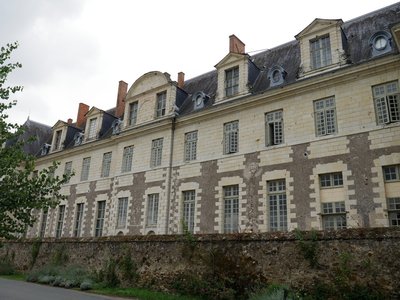
Bâtiment du 17e siècle de l’abbaye Saint-Maur de Glanfeuil - Amis saint Colomban HistoricalSaint-Maur Abbey in Glanfeuil
Archaeological excavations have attested a Gallo-Roman occupation of the site on the banks of the Loire.
According to legend, in the 6th century, Saint Benedict sent a disciple named Maurus, a monk from Mont Cassin, to Gaul. There he founded Glanfeuil Abbey, the first Benedictine abbey in Anjou, which he governed for almost forty years.
The abbey of Saint Maur, ruined by the Norman raids in the middle of the 9th century and reestablished in the same century under the reign of Louis le Bègue, had been, according to the custom of those times, built and fortified as a place of war.
It was rebuilt again towards the end of the 17th century and completed with an abbey house in the 18th century. Saint-Maur-de-Glanfeuil Abbey was restored in the middle of the 20th century.
Until the 1980s, the abbey belonged to the Assumptionists; it was a reception centre. They sold it to the Apprentices of Auteuil who, not having the right to build workshops, in turn sold it to the Departmental Council of Maine-et-Loire. Today it is a holiday centre.
The abbey cannot be visited.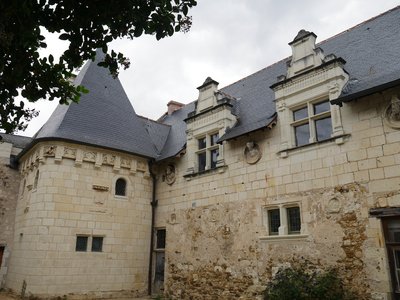
Tour du prieuré de Saint-Rémy-la-Varenne (15e siècle) - Amis saint Colomban TouristSaint-Rémy la Varenne Priory
A deed of foundation, dated 929, cedes the priory to the Abbey of Saint-Aubin d'Angers. A religious community settles there. In the 12th century a fresco was painted in the chapter house, one of the oldest in Anjou. From the 13th to the 14th centuries the priory prospers with its agricultural income, new buildings are added in the 15th century. Admire the superb fresco on the fireplace. After the Revolution the priory became a private estate and in 1988 the commune became the owner of the estate.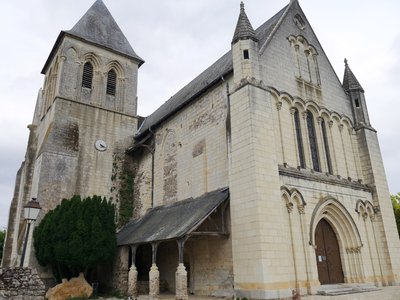
Le clocher et l’auvent d’entrée de l’église Saint-Aubin de Blaison-Gohier - Amis saint Colomban TouristSaint-Aubin Church in Blaison-Gohier
Saint-Aubin church replaces a collegiate church founded by Foulques Nerra, county of Anjou from 987 to 1040. The present church, in the Angevin Gothic style, was built between the mid 12th and mid 13th centuries. The choir vault was rebuilt in the 15th century, at the same time as the chapter of four canons and ten chaplains were given new stalls.
This fortified church had two covered walkways pierced with loopholes. It was built with a local stone, the blond tuffeau. This fine limestone rock, easily worked, was extracted from the quarries of Raindron, a troglodytic hamlet located in the south of the commune on the hillside of Aubance. It owes its colours to traces of iron oxide.
Text source: Extract from the information panels of the Saint-Aubin church.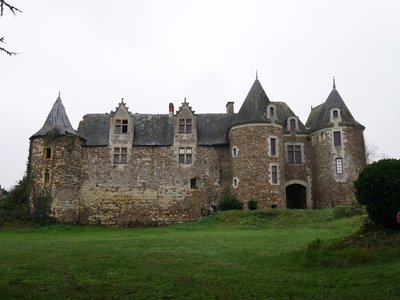
Vue du château de Blaison depuis la place Saint-Aubin - Amis saint Colomban HistoricalThe castle of Blaison-Gohier
This medieval fortress had seven towers. It was surrounded by a moat. On several occasions it was set on fire, destroyed and then abandoned...
Castle erected under the authority of Foulques III, known as Foulques Nerra, Count of Ajou, from 987 to 1040.
From 1415 to 1430 it belonged to Gilles de Rays, companion of Joan of Arc, better known under the name of Bluebeard accused of witchcraft. Then from the 15th century it is rebuilt and undergoes the influence of the Renaissance.
From the medieval fortress remain visible certain details such as fire hydrants, the base of a tower of the entrance châtelet, and a mark of the drawbridge that spanned the old moat.
Underground passages, and this time it's not a romantic legend, lead from the castle to various points in the village.
Today the castle is a private property that cannot be visited.
L’église Saint-Germain de Juigné-sur-Loire - Amis saint Colomban TouristSaint-Germain Church at Juigné-sur-Loire
In the 9th century it was a barn church. From 1150 to 1250, the school of architecture created the "Plantagenêt" style and transformed the church.
In 1852, a bell tower is added and the architect Duvêtre restores the nave and the transept in neo-gothic style.
What makes this church special is that the vaults are supported by canopies and not by pillars as in other churches.
Under the canopies, statues and columns decorate the choir.
The church has an important statuary.
Description
In front of the Thoureil church, turn right, rue de l'église, first street on the right, CR 14 de Cour Gain
- At the crossroads on the right, Route de Bougneuf, on the left, Chemin des Fourneaux, crossroads in front of the wood on the left, Chemin des Fourneaux then on the right in the wood of the Baillie, CR 28 de la Baillie, stay on the tarred road, rue de la Tour in Saint-Rémy-de-Varenne.
- Straight ahead at the crossroads with rue Saint-Jean-de-l'Isle, rue du Ran, right at the crossroads with rue Saint-Aubin, left at the crossroads with rue de la Mairie
- Exit the village, after the second street on the left, dirt track along the small wood, straight ahead meadow path along the wood on your right, junction with D 55, cross, take a path slightly on the left, straight ahead.
- In Perchard, left, asphalt road junction, right, first dirt road, Chemin de la Chênaie, straight ahead, rue de Chauvigné, right, ruelle du Haut Chevigné, right, Chemin du Manoir, second road on the left, Chemin de la butte de Gohier
- On the left junction asphalt road, on the right in the wood stay on your left, on the left crossroads with Chemin de la Grande Maison, rue de la Dube, on the left, cross the rue de la Petite Loire, take rue des Gabares, on the left Chemin des Sables
- At the crossroads on the left, crossroads asphalt road, rue des Basses Arches, on the left, rue de la Dolerie, on the right Place Saint-Aubin, continue, rue de la Grange Aux Dimes, on the left Chemin de terre before the crossroads, rue aux Loups, at the crossroads on the right then on the left, Chemin du Tertre Ruault, on the left crossroads asphalt road, on the left, fork on the right then at the crossroads on the left chemin de terre between vineyards and woods
- First path on the left at the edge of the vineyards in the hamlet, in the bend take a dirt track on the right, at the crossroads cross over take a dirt track on the edge of the wood, first path on the right between vineyards and wood. On the left on asphalt road cross the hamlet, at the crossroads take a dirt road on the left, on the edge of the wood and then of the vineyards, first path on the right in the vineyards, impasse du Saule, on the left rue de Chenan, on the right chemin de randonnée in the wood, cross the asphalt road, on the right route Blaison Saint-Sulpice
- Crossroads Chemin du Devant on the left, Chemin du devant, Chemin de l'Aireau, after the last house of the village, dirt road on the right, on the left tarred road, on the right road in the wood, cross the tarred road, crossroads route de Saint-Sulpice, first road on the left, cross St-Saturnin-sur-Loire, rue de l'Evière, rue du Logis des Bois, after the church, second road on the right, rue du Mont Rude
- Before turning right, straight ahead in the woods, turn right on asphalt road, rue du Vieux Bourg, cross the Route de la Vallée, Chemin des Ifes, right on rue du Molleton, left on Chemin des Dolmens, at the roundabout first road on the right, chemin de Pistrait, second road on the right in the woods, follow the river, right at the crossroads on asphalt road.
- Turn left on a dirt road, left in front of the nursery, turn right across the river and follow the path along the riverside.
- Carrefour chemin de terre turn right, go along the small lake, Chemin du Vieux Louet, you arrive at the church of Juigné-sur-Loire.
- Departure : Saint-Genulf Church, 5 Rue du Mail, 49 350 Le Thoureil
- Arrival : Saint-Germain Church, 32 Grande-Rue, 49 610 Juigné-sur-Loire
- Towns crossed : Pays de la Loire
Altimetric profile
Transport
Report a problem or an error
If you have found an error on this page or if you have noticed any problems during your hike, please report them to us here:



